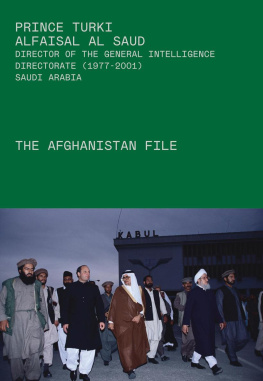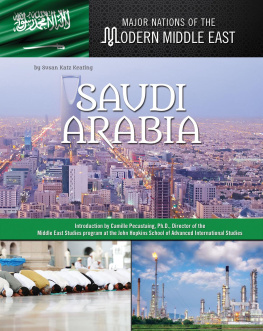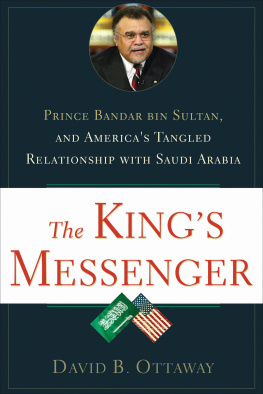THE
AFGHANISTAN
FILE
By Prince Turki AlFaisal Al Saud
THE AFGHANISTAN FILE
By Prince Turki AlFaisal Al Saud
Former Director of the General Intelligence Directorate
(19772001) Saudi Arabia

The Afghanistan File
First published in 2021 in Great Britain by
Arabian Publishing
50 High Street
Cowes
Isle of Wight
PO31 7RR
www.arabian-publishing.com
Copyright Prince Turki AlFaisal Al Saud, 2021
Written by Prince Turki AlFaisal Al Saud and Michael Field
Edited by Eleo Carson and Arthur Clark
Cover designed by Albino Tavares
Printed and bound in Great Britain by Clays Ltd., Elcograf S.p.A.
ISBN (hardback) 978-0-992980-88-7
ISBN (eBook) 978-1-911487-57-9
Prince Turki AlFaisal Al Saud asserts his moral right to be identified as the author of this book.
CIP data: A catalogue record for this book is available at the British Library.
All rights reserved. No part of this book may be reproduced, stored in a retrieval system, or transmitted in any form or by any means without prior permission of the copyright owners.
In association with

Contents
List of Illustrations & Maps
28 April 1979. Supporters of the Afghan communist regime march in the capital Kabul to mark the first anniversary of the communist April Revolution. (Getty Images)
30 December 1979. Muslim fighters pose with an assortment of weapons during a break in weapons training in Barikot in the Pakistani province of Khyber Pakhtunkhwa. (Associated Press/Steve McCurry)
1 February 1980. Mohammad Zia ul-Haq, President of Pakistan, at a rally of tribal chiefs in Peshawar. (Getty Images)
14 February 1980. Members of an Afghan Mujahideen patrol move through a rocky mountainous area in Kunar province of Afghanistan, 50 kilometres from the Pakistan border. (Associated Press)
2 February 1983. US President Ronald Reagan meets with leaders of the Afghan Mujahideen in the Oval Office. (Alamy)
1983. Ahmad Shah Massoud, military commander of the Mujahideen group Jamiat-i-Islami. (Shutterstock)
1986. President Mohammad Najibullah. (Alamy)
17 January 1987, Peshawar. Gulbuddin Hekmatyar, right, leader of Hizb-i-Islami, confers with Professor Abd Rabb Al-Rasul Sayyaf, Imam of Ittihad-i-Islami, during a meeting of Mujahideen listening to their leaders announcing the rejection of Kabuls offers of ceasefire and coalition government. (Getty Images)
11 September 1988. Burhanuddin Rabbani, left, leader of Jamiat-i-Islami, sitting with Abdullah Izzam, an Arab Mujahid. (AMRC)
1989. Osama Bin Laden, left, with anti-Soviet fighters in Afghanistan.
12 December 1989. Multan Battalion Commander, Lieutenant General Hamid Gul, during Zarb-e-Momin exercise-manoeuvres simulating an IndiaPakistan battle. (Getty Images)
15 February 1989. A convoy of Soviet vehicles leaving Afghanistan via the Friendship Bridge over the Amu Darya river on the border between Afghanistan and Uzbekistan. (AKG Images)
12 February 1989. Soviet soldiers parading at the withdrawal of troops from Afghanistan. (AKG Images)
1516 October 1990. Benazir Bhutto, former Prime Minister of Pakistan, campaigning for the Pakistan Peoples Party in the week before the Pakistani general election. (Getty Images)
4 May 1992. The evening sky is lit with tracer bullets and flares above Kabul during the nightly display by rival Mujahideen guerrilla groups continuing to battle for control of the city. (Getty Images)
April 1992, Peshawar. The author with Pakistani Prime Minister Nawaz Sharif organising a conference call between Ahmad Shah Massoud and Gulbuddin Hekmatyar to try to persuade them not to fight in Kabul. (Abdullah Mastour Al-Zahrani)
1992. Mujahideen rebels take Kabul. (Shutterstock)
1992. Abdul Rashid Dostum controlled the private buffer state on the southern borders of Turkmenistan and Uzbekistan. (Shutterstock)
1 May 1992. Hazrat Sibghatullah Mojaddedi acknowledging a crowd of supporters. (Getty Images)
29 May 1992. The author and Pakistani Prime Minister Nawaz Sharif arrive in Kabul and walk with Interim President Sibghatullah Mojaddedi. (Getty Images)
29 May 1992, Kabul. After the fall of Kabul, Sibghatullah Mojaddedi arrives at the airport with, on his right, Sharif Nawaz, Pakistani Prime Minister, and, to his left, the author. (Reuters)
7 March 1993, Islamabad, Pakistan. The author with General Muhammad Eid Al-Otaibi and his secretary, Ahmad Badeeb, Saudi Ambassador to Pakistan Yosuf Mutabaqqani, and Abdullah Mastour, the authors personal assistant, talking with Afghan leaders. (Abdullah Mastour Al-Zahrani)
7 March 1993, Islamabad, Pakistan: Afghan leaders (sitting), along with representatives of several Islamic countries, pray after the signing ceremony for an Afghan peace agreement. (Getty Images)
11 March 1993, Islamabad, Pakistan. Left to right: the author, Afghan President Burhanuddin Rabbani, Pakistani Prime Minister Nawaz Sharif and Gulbuddin Hekmatyar at a news conference. (Reuters)
1993. King Fahd of Saudi Arabia and Sheikh Abdulaziz bin Baz, Grand Mufti of Saudi Arabia, in Makkah, meeting Pakistani Prime Minister Nawaz Sharif and the Mujahideen leaders after the signing ceremony for an Afghan peace agreement. (Saudi Press Agency)
19 February 1994, Kabul. Two Shiite teenagers of the minority Hizb-i-Wahdat faction armed with Kalashnikovs peer around their bunker during an exchange of small-arms fire with troops belonging to the Afghan President. (Getty Images)
15 March 1994, Kabul. A man is captured by members of an enemy faction. (Getty Images)
20 October 1996. Ahmad Shah Massouds Mujahideen capture Bagram from the Taliban. (Getty Images)
1998, Khost, Afghanistan. Ayman El-Zawahri poses for a photograph with Osama Bin Laden. (Shutterstock)
16 December 2001. Anti-Taliban Afghan fighters watch explosions from US bombings in the Tora Bora mountains in Afghanistan. (Reuters)
Plaque given to the author by CIA head William Casey. The words in Arabic state Never Trust the Russians, a maxim of one of the Afghan kings. (Abdullah Mastour Al-Zahrani)
7 October 2019, Riyadh. The author receiving the decoration for the Afghan award of Ghazi Mirbajah Khan. (Abdullah Mastour Al-Zahrani)
Maps
- Modern-day regional map
- Afghanistan (1980s provincial borders)
- Afghanistan/Pakistan (modern-day provincial borders)

Modern-day regional map |

Afghanistan (1980s provincial borders) |

Afghanistan/Pakistan (modern-day provincial borders) |
Note on spelling and place names
The names of people, places and organisations mentioned in this book are rendered in commonly used anglicised spellings whenever available. Technical transliteration has been avoided for the sake of readability.














